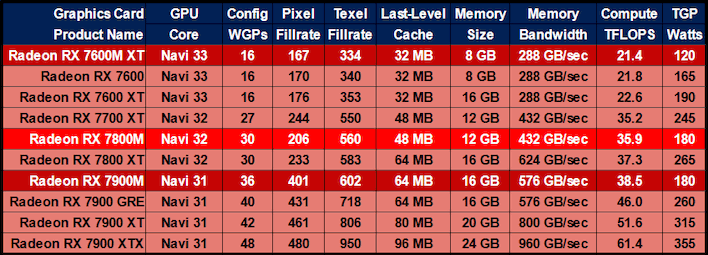One-Netbook has aggressively gone after the handheld, portable, and mini PC markets for several years now. It first ventured into the world of eGPUs about a year ago, with the sleek and handy AMD Radeon RX 7600M XT-powered OneXGPU. Now it has created a far more powerful (and somewhat bulkier) sequel to its first-gen device, dubbed the OneXGPU 2, which has just emerged from a successful crowdfunding campaign. What sets One-Netbook’s second generation portable eGPU apart from its predecessor – and the competition – is the inclusion of the recently unveiled Radeon RX 7800M GPU.
Coincidentally, the first pre-launch rumors we saw regarding the RX 7800M GPU seemed to come from One-Netbook, via the firm’s teasing trailers on Chinese social media. At that time, we were unsure about what portable goodness this unannounced laptop GPU might feature. Now we know it is a rather potent part, that by several key metrics sits snugly between the desktop AMD Radeon RX 7700 XT and RX 7800 XT graphics cards. From another perspective, it is a serious rival for the better-known Nvidia GeForce RTX 4070, but designed for portables.

OneXGPU 2 First Impressions
The idea of such a high performance GPU at the heart of a portable eGPU is enticing, so lets get up close and personal with the OneXGPU 2 to discern what this device is all about. We will move onto benchmarks on the next page. We’ll start with our first impressions of this portable eGPU and PC docking solution, and detail its main features and specifications.
The first thing we feel compelled to highlight is that the OneXGPU 2 has physically grown considerably compared to its RX 7600M XT-powered predecessor. One-Netbook’s design team needed to design a larger chassis that could handle the beefier GPU and its power demands, and its requisite cooling solution. We won’t do too many backwards comparisons here, but the OneXGPU 2 is considerably larger at 229.5 x 175 x 43mm, compared to the 196 x 120 x 32mm of its predecessor. Moreover, the weight of the device has almost doubled to 1.61kg (3.5 pounds). The more portable, previous-gen RX 7600M XT powered devices is configurable between 100W and 120W modes, however, the more powerful OneXGPU 2 starts at 130W and will operate at up to 180W at a press of its turbo button.
If you’d like to peruse the OneXGPU’s tech specs, they should all be covered in the table above. As well as eGPU functionality, the OneXGPU 2 does a pretty good job as a USB-C docking station as well. This could make it handy for notebook users who return home to dock their laptops to their large-screen monitors, for example. Its 100W reverse charging capability makes it a great one-cable dock when using USB4. Those wishing to make use of the OCuLink interface, however, will still need to plug in a USB4 cable to enjoy all the extra docking ports, microSD card reader and M.2 2280 SSD storage expansion.

The OneXGPU isn’t just for notebooks, though. This eGPU could also a pretty good companion to handhelds and mini PCs – and such use-cases were probably the motivation for One-Netbook to develop this second generation product.
Connecting The OneXGPU 2
We have already explained that this device offers all its functionality via a single 40Gbps USB-C cable connection. If your system has OCuLink and you only use this 64Gbps port to connect to your device though, you will miss-out on the docking and extra storage functions. Thus, most OCuLink users might wish to always connect both interfaces. With both cables connected the device uses USB4 for docking functionality and OCuLink for graphics.
We had three devices on hand which seemed like great candidates for an eGPU: a Dell Latitude 7400 with Intel Core i5-8365U and UHD Graphics, a Geekom A8 mini PC with Ryzen 9 8945HS and integrated Radeon 780M graphics @28W, and a Geekom Megamini G1 with Intel Core i9-13900H @45W and NVIDIA GeForce RTX 4060 Laptop GPU @120W.
Sadly, the Dell laptop’s Thunderbolt 3 port didn’t play nice, and was constantly connecting and disconnecting, making the eGPU unusable. Seeking out and installing the latest BIOS, Intel Thunderbolt drivers, and AMD graphics drivers didn’t help the older Dell system.
Moving onto the Geekom A8, connecting and using the OneXGPU 2 was pretty easy. This machine has a USB4 port and already had Radeon drivers installed, but an update was needed to the latest Adrenalin 24.10.1 driver to support this new AMD GPU. After the update, the eGPU delivered a significant performance boost, as you will see on the next page — it was multiple times faster than the iGPU in all our tests.
Lastly, the Geekom Megamini G1 already includes an Nvidia GeForce RTX 4060 Laptop GPU with 120W TDP – a respectable gaming GPU for space constrained devices like laptops and mini PCs. After we installed the latest AMD Radeon driver it recognized and could use the RX 7800M-powered eGPU without further tinkering. Handily, this mini PC offers both USB4 and OCuLink interfaces. Thus this device would let us see how much better the RX 7800M is compared to a 4060 laptop GPU, as well as comparing the relative merits of the different PC connection interfaces available.
With every setup, we ran tests using the OneXGPU 2 in both its 130W and 180W modes. Let’s check out performance, next…




